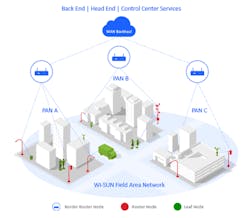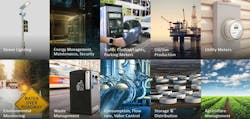What you’ll learn:
- What is the Wi-SUN field area network (FAN)?
- Why Wi-SUN FAN is the ideal protocol for smart cities.
- How Wi-SUN FAN improves smart-city security, interoperability, and scalability.
Driven by a global need for increased sustainability, reductions in greenhouse gas emissions and waste, and efficient resource usage, cities around the world are transforming into smart cities. Designed with the underlying goal of improving city operations and overall quality of life for residents, smart cities are urban areas utilizing Internet of Things (IoT) advances to efficiently manage city assets, resources, and services. Smart cities digitize aspects of modern urban life, including utilities, civic services, traffic control and public transport, and water and waste networks.
A key driver of widespread interest in the smart-city transformation is the rapidly growing global urban population. Each week, an estimated 1.3 million people move from rural to urban areas, and the U.N. projects a startling 68% of the world’s population will live in urban centers by 2050. Growing urban populations put tremendous pressure on cities’ infrastructures, and cities in turn significantly stress the environment and our limited natural resources.
Designing Human, Environmental-Centered Solutions
The foundational technological arsenal of smart cities is based on internet and communications systems. With more sensors and connectivity in the field and more algorithms running in data centers, the inevitable outcome is smarter and higher-efficiency decision-making.
However, we should be cautious regarding this vision of smart cities and avoid focusing only on the technological aspect of each problem at hand. Smart-city designs are trying to solve very complex, human problems. Cities are an interconnected web of infrastructure, organizations, and residents. As with every organic complex system, its dominant property is its complexity rather than its subdivisions or sub-entities.
As uncovered by the ecology pioneers of the 20th century, such complex systems (think ant colonies, topsoil, or American elections) should, for best outcomes, be treated holistically. Interacting with or modifying a part in isolation rarely induces full-system improvements. In other words, blindly throwing more technology at our urban conflicts does not—at best—guarantee solving them and could—at worst—cause more harm than good. We need to remember a city is a web of interconnected, interlocked entities: a social organism of mass scale.
Thus, a more constructive approach to smart cities begins with seeing and acknowledging the entire urban system as a whole. If a problem is resolved without consideration for its ecology, it can lead to further, more consequential problems. For example, a city may aim to reduce its greenhouse emissions by making its power networks more efficient to reduce energy consumption. Yet residents may see lower energy bills and become less stringent with their energy use, bringing the system back to its energy equilibrium point and consuming the same or more energy than it did before.
To that degree, smart-city technological pioneers need to emphasize the big-picture impact of their solutions as much as the one-to-one relationships. Therefore, a technology that reliably and sustainably disrupts the way in which a city operates must consider the vastness and depth of what comprises a city. While mythical idealizations of smart cities—abstract modern designs, flying delivery drones, and self-driving cars—could potentially become reality, this vision focuses on the technological solutions, leaving the human qualities out of the picture.
Connecting the Dots with Wi-SUN
The emphasis around human and environmental values doesn’t undermine the richness offered by the technological solutions currently at hand, namely big data and IoT. IoT networks expose valuable leverage points that can trigger vast constructive impact, and city planners are just now starting to tap into their potential.
Technological players must serve as guides for smart-city development and ensure cities deploy adaptive wireless platforms that are flexible and encompassing. As more companies and organizations recognize the unique nuances of designing efficient smart cities, a strong movement within the electronics industry is moving toward wireless standardization for smart-city applications.
In 2011, a group of visionary leaders initiated the idea of interoperable smart-city networks based on the IEEE 802.15.4g standard, leading to the formation of the Wi-SUN (Wireless Smart Ubiquitous Network) Alliance. With more than 300 member companies, Wi-SUN utilizes widely adopted and proven industry standards to enable an open ecosystem of interoperable solutions with endless possibilities to futureproof smart-city networks.
The Wi-SUN field area network (FAN) is a highly robust, low-power IoT wireless mesh network boasting numerous data-rate options to support large-scale IoT networks. What establishes Wi-SUN as a true smart-city protocol is its scalability, security, interoperability, and breadth of supportable existing and emerging applications. Wi-SUN also allows for mode-switching techniques to adjust data rates based on application needs.
Up until now, most smart-city applications have used proprietary networks that are typically designed for specific applications with limited security and flexibility to upgrade. They also typically employ a “star” architecture where devices communicate with a base-station receiver.
However, Wi-SUN is a self-forming, self-healing mesh network with thousands of nodes rather than depending on one base station, which improves its reliability and resilience (Fig. 1). The Wi-SUN FAN architecture can constantly reroute data across these thousands of nodes in the case of connection issues. This allows devices to receive full network connectivity and continuous support of services across the city when they need it most, such as during extreme storms, cyberattacks, and/or power-usage constraints resulting in rolling blackouts.
When compared to traditional low-power wide-area networks (LPWAN), Wi-SUN offers higher data rates and lower latency (see table) along with low power, security, and interoperability.
Furthermore, Wi-SUN FAN provides flexibility in data rates and energy consumption, allowing users to address smart-city and other applications more broadly. Smart-city applications place high demands on the underlying network infrastructure, requiring a high degree of security, reliable connections, resilience in the event of faults or changing conditions, and much more. Wi-SUN FAN provides secure, cost-effective, and resilient connectivity in a wide variety of topographical environments with minimal additional infrastructure, from rural areas to dense urban neighborhoods.
Smart-city developments today are oriented toward smart metering, smart street-lighting systems, public safety, traffic monitoring, noise detection, and pollution monitoring, all of which Wi-SUN is designed to accommodate (Fig. 2). Wi-SUN also is well-suited to handle the integration of smart-city sensors (waste management, vending machines) and distributed energy resources (DERs) onto the grid.
Securing Our Cities’ Most Vulnerable Assets
Yet another differentiator of Wi-SUN is its security benefits, creating tremendous opportunity in the design of smart cities. With hospitals, government agencies, public transport, business organizations, and power grids becoming more vulnerable to cyberattacks, zero-risk-tolerance security standards must be set in place. Cities are becoming nodes within networks of interconnected cities, and a system of interconnected cities is as weak as its weakest link, making network cybersecurity non-negotiable.
Created with its users’ safety and security in mind, Wi-SUN has several built-in security functions to ensure operational security. One of the most significant functions is that security authentication goes all the way back to the cloud provider, which isn’t the norm for most protocols today. Wi-SUN also observes cybersecurity rules in designing a network to ensure reliable operations, including end-to-end security, encryption, key management, and network isolation in the event of a security breach.
A unique feature of Wi-SUN is its native public-key-infrastructure (PKI) integration, certificate-based mutual authentication, and proven data encryption and key exchange algorithms. Wi-SUN FAN access control is based on PKI and modeled after a Wi-Fi security framework. Each Wi-SUN device also has a unique certificate signed by a Certification Authority at its point of manufacturing.
Smart-city initiatives hold human quality of life and the environmental impact to a higher standard. Enterprises working with and within the ecosystem of city infrastructure are likely to reap the largest rewards, as their projects have higher chances of sustainable success. Wi-SUN has been built with this philosophy in mind—its technological features enable city planners and technology architects to connect and futureproof the city’s infrastructure successfully, with the ultimate benefits aimed at residents and environmental resources.
In the coming years, we will continue to see IoT advances influence the transition to smart cities worldwide. It will remain imperative to balance the numerous elements of a city when transforming its infrastructure and the lives of its citizens, and just as critical to balance the priorities of advancing technology, promoting sustainability, and increasing quality of life at the individual and group levels.



